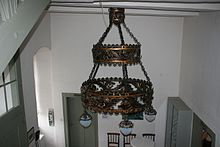Fresekenhof
The Fresekenhof is a former Burgmannenhaus in Neheim , originally from the 14th century and newly built in the 17th century .
building
The building originally dates from the 1360s. Against the background of armed conflicts between the County of Arnsberg and the County of Mark , the fortifications of Neheim Castle were strengthened at this time. Among other things, the Fresekenhof was built on the city wall for this purpose. Together with the "Schüngelschen Burghaus" located to the north, which no longer exists today, the building secured the city gate facing west. Remnants of the city wall also make the former defensive character clear on today's building.
history
After the transfer of the county of Arnsberg to the Archdiocese of Cologne, the sovereign Friedrich III. on August 28, 1377 the house together with land owned by the castle man Wilhelm Freyseken. This came from the knight family of Nihem. The family was later called Freseken .
The building remained in family ownership until the 16th century. The new owner was Captain Israel, one of the co-founders of the St. Johann Baptist Rifle Society from 1607. In 1633 the Fresekenhof was destroyed by Swedish-Hessian troops.
The next owner was Ferdinand Lothar von Bönnighausen, colonel in the service of Kurkölner and illegitimate son of Field Marshal Lothar Dietrich von Bönninghausen . The new owner had the building rebuilt in 1688 on the foundation walls and using the preserved vaults of the previous building. For the next three generations, the property remained in the Bönnighausen family.
In 1699 it became the property of the Chamberlain and Councilor Friedrich von Wrede-Lohe. He was followed in 1718 by Major General Stephan Christian von Folleville. After his death, his widow lived in the Fresekenhof before she was murdered in 1749.
Clemens Lothar Ferdinand von Fürstenberg zu Herdringen acquired the building in 1766. 208 acres of land and hunting rights were associated with it. After 1807 the house served as a widow's residence. It was also rented as a court seat between 1802 and 1892. In 1820 the house was redesigned in the classical style. After the court moved out, the Fresekenhof became the seat of a state chief forester until 1918. After the Second World War it housed a refugee family until 1955, later a private museum and storage rooms.
Efforts by Baron von Fürstenberg to re-use it as a hotel or museum, for example, came to nothing with the construction of the federal motorway 46 directly behind the Fresekenhof. In 1980 the council of the city of Arnsberg decided to buy the building and set up a community center.
today
Today the city of Arnsberg uses the fireplace room in the building for smaller receptions and as a wedding room for civil marriages. Striking details of the room, the former kitchen of the courtyard, are next to the fireplace, the stone floor in front of the fireplace and an old stone sink. On two walls there is a gallery of the honorary citizens of Neheim-Hüsten.
A striking accessory in the stairwell is the chandelier, an artistic work that weighs around 90 kilograms.
Other users of the building are the local rifle brotherhood, the hunting club and the Neheim-Hüsten home association. There is also a permanent exhibition about Franz Stock .
Bird shooting for the rifle festival takes place in the courtyard of the Freseken castle house.
literature
- Friedhelm Ackermann, Alfred Bruns: Castles, palaces and monasteries in the Sauerland. Strobel, Arnsberg 1985, ISBN 3-887-93-006-14 , pp. 98-99.
- Jens Friedhoff : Theiss Castle Guide. Sauerland and Siegerland. Theiss, Stuttgart 2002, ISBN 3-8062-1706-8 , pp. 58-59.
- Uwe Haltaufderheide: The architectural monuments of the city of Arnsberg. Collection period 1980–1990. City of Arnsberg, Arnsberg 1990, ISBN 3-928394-01-0 , pp. 239–241.
Web links
Coordinates: 51 ° 27 ′ 19 ″ N , 7 ° 57 ′ 18.2 ″ E


